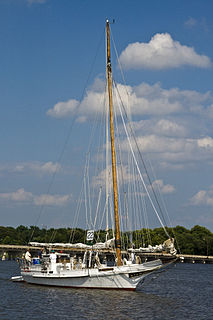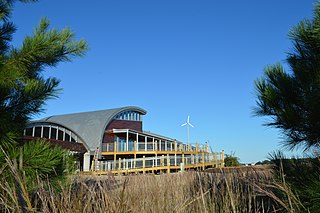
The Chesapeake Bay is the largest estuary in the United States. The Bay is located in the Mid-Atlantic region and is primarily separated from the Atlantic Ocean by the Delmarva Peninsula with its mouth of the Bay at the south end located between Cape Henry and Cape Charles. With its northern portion in Maryland and the southern part in Virginia, the Chesapeake Bay is a very important feature for the ecology and economy of those two states, as well as others surrounding within its watershed. More than 150 major rivers and streams flow into the Bay's 64,299-square-mile (166,534 km2) drainage basin, which covers parts of six states and all of District of Columbia.
Claiborne is an unincorporated community in Talbot County, Maryland, United States. The village is located on the eastern shore of the Chesapeake Bay near the mouth of the Eastern Bay at 38°50′15″N76°16′40″W, and uses ZIP code 21624. The 2000 U.S. Census listed the population as 147 and the number of homes as 84, slightly down from its 1941 population of 156. Between 1890 and 1930, the village was a busy port for passenger and then automobile ferry service across the Chesapeake Bay, with numerous stores and motels/resorts, including Maple Hall. A post office was added in 1893 and the Protestant Episcopal Church of Claiborne was built in 1898. In 1912, an elementary school and Methodist Church were added. Before 1912, students attended school in nearby McDaniel. The town's first school consisted of the kitchen of the local railroad pavilion, used as a classroom. In 1913, the town became home to the Claiborne Fresh Air Association, Inc., which was formed for the purpose of providing 10 weeks of fresh air and summer vacation for children who had been exposed to tuberculosis. The role of Claiborne as a terminal for cross-Bay ferries was diminished in 1930 when the primary route shifted to Matapeake in Kent Island. It ended altogether in 1938 when the direct connection from Annapolis to Claiborne was terminated and only an auxiliary shuttle between Claiborne and Romancoke on Kent Island remained. This ended in 1952, with the opening of the Chesapeake Bay Bridge; thus ended all ferry service to Claiborne.

The Charles Darwin Foundation was founded in 1959, under the auspices of UNESCO and the World Conservation Union. The Charles Darwin Research Station serves as headquarters for The Foundation, and is used to conduct scientific research and promote environmental education.

Chesapeake College is a public community college with its main campus in Wye Mills, Maryland and a satellite campus in Cambridge. It was the first regional community college in the state and serves the five Mid-Shore counties: Caroline, Dorchester, Kent, Queen Anne's, and Talbot.

The Smithsonian Environmental Research Center (SERC) is a United States 2,650-acre (10.7 km2) environmental research and educational facility operated by the Smithsonian Institution. It is located on the Rhode and West Rivers near Edgewater in Anne Arundel County, Maryland, near the western shore of Chesapeake Bay. The center's focus of study is the ecosystems of coastal zones, particularly in the Chesapeake Bay estuary and nearby wetlands.
Philip Merrill was an American diplomat, publisher, banker, and philanthropist.

The Echo Hill Outdoor School was founded in 1972 by Peter P. Rice Jr. and is located near Betterton in Kent County on Maryland's Eastern Shore. The School provides 1 to 5 day programs for children and adults from public and private schools throughout the Mid-Atlantic in experiential education and the ecology of the Chesapeake Bay and its surrounding ecosystems.
The Chesapeake Biological Laboratory (CBL) is a marine science laboratory on the Chesapeake Bay in Solomons, Maryland, and it is the oldest state-supported marine laboratory on the East Coast of the U.S. It was founded in 1925 in a small waterman's shack by Dr. Reginald V. Truitt and is part of the University of Maryland Center for Environmental Science.

The Lynnhaven River is a tidal estuary located in the independent city of Virginia Beach, Virginia, in the United States, and flows into the Chesapeake Bay west of Cape Henry at Lynnhaven Inlet, beyond which is Lynnhaven Roads. It has a small, developed watershed covering 64 square miles (170 km2), terminating at Lynnhaven Bay. It was once famous along the East Coast of the United States for its oysters, which declined through pollution and runoff. It is now being restored by the Lynnhaven River Now restoration project based out of the Brock Environmental Center. A proposed comprehensive project for ecosystem restoration of the Lynnhaven River Basin is currently under consideration by the United States Congress.

The Chesapeake Bay Program is the regional partnership that directs and conducts the restoration of the Chesapeake Bay in the United States. As a partnership, the Chesapeake Bay Program brings together members of various state, federal, academic and local watershed organizations to build and adopt policies that support Chesapeake Bay restoration. By combining the resources and unique strengths of each individual organization, the Chesapeake Bay Program is able to follow a unified plan for restoration. The program office is located in Annapolis, Maryland.
The Chesapeake Bay Foundation (CBF) is a non-profit organization devoted to the restoration and protection of the Chesapeake Bay in the United States. It was founded in 1967 and has headquarters offices in Annapolis, Maryland. The foundation has field offices in Salisbury, Maryland; Harrisburg, Pennsylvania; Richmond, Virginia; Norfolk, Virginia and Washington, D.C.
The Maryland School of Public Policy is one of 14 schools at the University of Maryland, College Park. The school is located inside the Capital Beltway and ranks 16th nationally for schools of public policy according to U.S. News & World Report (2012).

O'Neill Sea Odyssey is an American non-profit organization located in Santa Cruz, California. It was founded in 1996 by wetsuit innovator Jack O'Neill and provides students with hands-on lessons on marine habitat and the relationship between the oceans and the environment.
The McCall Outdoor Science School (MOSS) is a year-round learning center that serves over 2500 Idaho K-12 students annually in residential and outreach settings. Field instructors for outdoor science programs are University of Idaho College of Natural Resources graduate students completing a certificate and master's degree in environmental education. The McCall Outdoor Science School also offers programs open to the public including Field Seminars, Faculty Lectures, and Community Partnerships. MOSS is Idaho's only residential outdoor science school.

The Chesapeake Bay Maritime Museum is located in St. Michaels, Maryland, United States and is home to a collection of Chesapeake Bay artifacts, exhibitions, and vessels. This 18-acre (73,000 m2) interactive museum was founded in 1965 on Navy Point, once a site of seafood packing houses, docks, and work boats. Today, the museum houses the world's largest collection of Chesapeake Bay boats and provides interactive exhibits in and around the 35 buildings which dot the campus. The museum also offers year-round educational seminars and workshops.

The Virginia Institute of Marine Science (VIMS) is one of the largest marine research and education centers in the United States. Founded in 1940, VIMS is unique among marine science institutions in its legal mandate to provide research, education, and advisory service to government, citizens, and industry. Funding for VIMS comes from the Commonwealth of Virginia, grants and contracts from federal and state agencies, and private giving. The School of Marine Science (SMS) at VIMS is the graduate school in marine science for the College of William & Mary. VIMS offers M.S., Ph.D., and professional M.A. degrees in marine science. The school has 52 faculty members, an enrollment of 80-100 students, and includes 4 academic departments. VIMS' main campus is located in Gloucester Point, Virginia.
Clagett Farm, once known as Navajo, is a 285-acre (1.15 km2) working farm located in Upper Marlboro, Maryland. It is owned and operated by the Chesapeake Bay Foundation.
The EcoCenter at Heron's Head Park is an environmental education facility located at 32 Jennings Street in the Bayview–Hunters Point neighborhood of San Francisco, California.
Donald F. Boesch is a professor of marine science and, from 1990 to 2017, president of the University of Maryland Center for Environmental Science. From 2006-2017, he concurrently served as Vice Chancellor for Environmental Sustainability for the University System of Maryland. In 2010, he was appointed by President Barack Obama as a member of the National Commission on the BP Deepwater Horizon Oil Spill and Offshore Drilling to investigate the root causes of the blowout at the Macondo Prospect in the Gulf of Mexico.

The Chesapeake Bay Foundation's (CBF) Brock Environmental Center is located on the banks of the Lynnhaven River in Virginia Beach, Virginia. It is designed to meet the highest environmental standards in accordance with The U.S. Green Building Council's Leadership in Energy and Environmental Design and the Living Building Challenge. Home to CBF's Hampton Roads staff and local conservation group, Lynnhaven River NOW, the Brock Center will benefit the larger public with spaces indoors and out for community and student groups.











